International Journal of Computer Network and Information Security @ijcnis
Статьи журнала - International Journal of Computer Network and Information Security
Все статьи: 1166
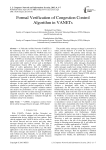
Formal Verification of Congestion Control Algorithm in VANETs
Статья научная
A Vehicular Ad-Hoc Networks (VANETs) is the technology that uses moving cars as nodes in a network to create a mobile network. VANETs turn every participating car into a wireless router, allowing cars of each other to connect and create a network with a wide range. VANETs are developed for enhancing the driving safety and comfort of automotive users. The VANETs can provide wide variety of service such as Intelligent Transportation System (ITS) e.g. safety applications. Many of safety applications built in VANETs are required real-time communication with high reliability. One of the main challenges is to avoid degradation of communication channels in dense traffic network. Many of studies suggested that appropriate congestion control algorithms are essential to provide efficient operation of the network. However, most of congestion control algorithms are not really applicable to event-driven safety messages. In this paper we propose congestion control algorithm as solution to prevent congestion in VANETs environment. We propose a complete validation method and analyse the performance of our congestion control algorithms for event-driven safety messages in difference congested scenarios. The effectiveness of the proposed congestion control algorithm is evaluated through the simulation using Veins simulator.
Бесплатно
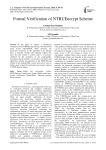
Formal Verification of NTRUEncrypt Scheme
Статья научная
In this paper we explore a mechanized verification of the NTRUEncrypt scheme, with the formal proof system Isabelle/HOL. More precisely, the functional correctness of this algorithm, in its reduced form, is formally verified with computer support. We show that this scheme is correct what is a necessary condition for the usefulness of any cryptographic encryption scheme. Besides, we present a convenient and application specific formalization of the NTRUEncrypt scheme in the Isabelle/HOL system that can be used in further study around the functional and security analysis of NTRUEncrypt family.
Бесплатно
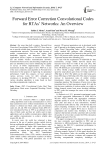
Forward Error Correction Convolutional Codes for RTAs' Networks: An Overview
Статья научная
For more than half a century, Forward Error Correction Convolutional Codes (FEC-CC) have been in use to provide reliable data communication over various communication networks. The recent high increase of mobile communication services that require both bandwidth intensive and interactive Real Time Applications (RTAs) impose an increased demand for fast and reliable wireless communication networks. Transmission burst errors; data decoding complexity and jitter are identified as key factors influencing the quality of service of RTAs implementation over wireless transmission media. This paper reviews FEC-CC as one of the most commonly used algorithm in Forward Error Correction for the purpose of improving its operational performance. Under this category, we have analyzed various previous works for their strengths and weaknesses in decoding FEC-CC. A comparison of various decoding algorithms is made based on their decoding computational complexity.
Бесплатно
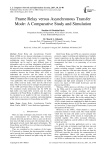
Frame Relay versus Asynchronous Transfer Mode: A Comparative Study and Simulation
Статья научная
Frame Relay and Asynchronous Transfer Mode (ATM) are two famous technologies in wide-area networks that use the virtual circuits for connecting and multiplexing many branches and networks. Those technologies can be used to carry different types of information such as real-time information which needs high data rate, low delay and an efficient throughput of the network's data communication devices. This paper is a study based on simulation for comparative performance evaluation between the Frame Relay and ATM to understand the overview and the nature of these technologies focusing on real-time applications using the OPNET simulation tool for analyzing the performance of voice application. The evaluation parameters are traffic sent, traffic received, delay, Jitter and the end-to-end delay which have been used to compare the performance of the ATM and Frame Relay in high-speed networks. The simulation results demonstrate that the ATM has high traffic sent, high traffic received, and less delay compared to the Frame Relay. In addition, this paper may be considered as an insight for the new researchers to guide them to an overview, essentials, and understanding of the virtual connections for Frame Relay and ATM.
Бесплатно
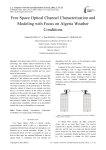
Free Space Optical Channel Characterization and Modeling with Focus on Algeria Weather Conditions
Статья научная
Free-Space Optics (FSO) is a wireless optical technology that enables optical transmission of data, voice and video communications through the air, up to 10 Gbps of data, based on the use of the free space (the atmosphere) as transmission medium and low power lasers as light sources. Quality and performance of FSO links are generally affected by link distance and weather conditions like environmental temperature and light, sun, fog, snow, smoke, haze and rain. In this paper we study the effects of weather conditions on the performance of FSO links, taking the climate of Algeria as an example, and since there is no known analysis on the effects of weather conditions in this country, this paper offers an attempt to analyze and identify the challenges related to the deployment of FSO links under Algeria's weather. We also present a Graphic User Interface "GUI" to provide an approximate availability estimate of an atmospheric optical link in term of probability of connection.
Бесплатно
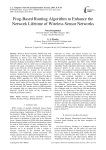
Frog-Based Routing Algorithm to Enhance the Network Lifetime of Wireless Sensor Networks
Статья научная
Wireless Sensor Networks (WSN) finds wide applications in both Target tracking and Environment monitoring in almost every field, with the demand growing day by day. Routing is considered as the most important challenge in designing a WSN. To enhance the Network Lifetime, there is a need to have a balanced load sharing with equal consumption of Energy by all the nodes in the Network. Several Routing Protocols have been developed that are inspired by the collective behaviour and principles of social insects and animal societies. Inspired by the Frog behaviour, we in this paper propose an Energy efficient distributed Frog-Based Routing (FBR) algorithm for WSN. Routing path is established considering the nodes that have high residual Energy which makes all the nodes die around the same time, prolonging the Network Lifetime. Simulation was carried out using NS2 and the results of FBR algorithm are compared with two other Energy Efficient Routing Protocols LEACH and SPIN for the evaluation of different performance metrics.
Бесплатно
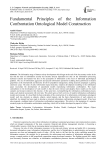
Fundamental Principles of the Information Confrontation Ontological Model Construction
Статья научная
The information stage of human society development which began at the end of the last century results in the fact that the state of information security has become directly dependent not only on the information processing technical systems and features but also on the perception of information at the level of individual psychological qualities. The use of information aggression and special information operations including those performed in modern geopolitics at the international and domestic levels for population management, during electoral campaigns is gaining enormous scope. The tasks of early information impact detection, situation development modeling in the information space necessitate the development of specialized models reproducing information confrontation. The major contradiction in the development of such models is that the more relevant and adaptive these models are the more complex and resource-intensive they become. At the same time, oversimplifying the information confrontation process makes such models inconsistent with real risks. This article gives a brief overview of modern information confrontation models and concepts. It is described the basic principles of the construction of an information confrontation ontological model: such key elements as subjects, objects, actual impacts, and the basic characteristics of each element are identified. An attempt has been made to develop a universal information confrontation ontological model. It has been also proposed a multipart tuple of information confrontation representation. This article is the beginning of a separate research project on information confrontation modeling, which will be further developed in papers to follow.
Бесплатно
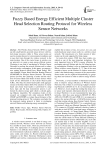
Статья научная
The Wireless Sensor Network (WSN) is made up with small batteries powered sensor devices with lim-ited energy resources within it. These sensor nodes are used to monitor physical or environmental conditions and to pass their data through the wireless network to the main location. One of the crucial issues in wireless sensor network is to create a more energy efficient system. Clustering is one kind of mechanism in Wireless Sensor Networks to prolong the network lifetime and to reduce network energy consumption. In this paper, we propose a new routing protocol called Fuzzy Based Energy Effi-cient Multiple Cluster Head Selection Routing Protocol (FEMCHRP) for Wireless Sensor Network. The routing process involves the Clustering of nodes and the selection of Cluster Head (CH) nodes of these clusters which sends all the information to the Cluster Head Leader (CHL). After that, the cluster head leaders send aggregated data to the Base Station (BS). The selection of cluster heads and cluster head leaders is performed by using fuzzy logic and the data transmission process is performed by shortest energy path which is selected applying Dijkstra Algorithm. The simulation results of this research are compared with other protocols BCDCP, CELRP and ECHERP to evaluate the performance of the proposed routing protocol. The evaluation concludes that the proposed routing protocol is better in prolonging network lifetime and balancing energy consumption.
Бесплатно
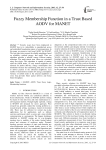
Fuzzy Membership Function in a Trust Based AODV for MANET
Статья научная
Security issues have been emphasized in MANET due to its vulnerability to unauthorised access and unshielded broadcasting nature of communication. In this paper we present a trust based AODV for MANET. The trust takes into account the eligible neighbours based on reliability, residual energy, and speed. Thus our algorithm provides a reliable, energy efficient routing technique. The multi-criteria trust values are calculated using fuzzy-logic. This algorithm is capable of putting aside the selfish nodes. As only trusted neighbours are selected for packet delivery, energy consumption also diminishes because the transmitting node does not need to deliver packets to the untrusted neighbours. Less number of transmissions renders low energy consumption. Absence of selfish nodes in the selected neighbours at every hop provides better packet delivery and hence better throughput.
Бесплатно
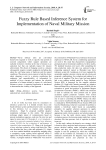
Fuzzy rule based inference system for implementation of naval military mission
Статья научная
Naval military units are convoluted frameworks required to work in specific time periods in seaward assignments where support operations are radically restricted. A decline at the time of mission is an analytical fact that can radically impact the mission achievement. The choice of changing a unit to a mission subsequently requires complex judgments including data about the well being status of hardware and the natural conditions. The present system expects to help the choice about changing a unit to a mission considering that ambiguity and unpredictability of information by methods of fuzzy concepts and imitates the selection procedure of a human trained by means of a rule-based inference system. A numerical application is introduced to demonstrate the viability of the approach.
Бесплатно
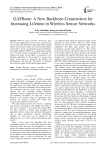
GAFBone: A New Backbone Construction for Increasing Lifetime in Wireless Sensor Networks
Статья научная
Wireless sensor networks, which have been used in many applications in recent years, consist of tiny sensor nodes with restriction in processing ability and the battery unit. Because of that, one of the crucial problems in this field is power consumption and network lifetime. Geographic Adaptive Fidelity is a routing protocol which tries to reduce energy consumption by powering off unnecessary nodes. In this paper, we proposed a new backbone algorithm for this protocol to saving more energy which causes to improving the lifetime and performance of the networks. The results of simulation show that active grids will be halved approximately.
Бесплатно
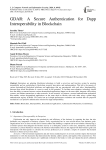
GDAR: A Secure Authentication for Dapp Interoperability in Blockchain
Статья научная
Enterprises are adopting blockchain technology to build a server-less and trust-less system by assuring immutability and are contributing to blockchain research, innovation, and implementation. This led to the genesis of various decentralized blockchain platforms and applications that are unconnected with each other. Interoperability between these siloed blockchains is a must to reach its full potential. To facilitate mass adoption, technology should have the ability to transact between various decentralized applications (dapps) on the same chain, integrate with existing systems, and initiate transactions on other networks. In our research, we propose a secured authentication mechanism that enables various decentralized applications on the same chain to interact with each other using a global dapp authentication registry (GDAR). We carried out an in-depth performance evaluation and conclude that our proposed mechanism is an operative authentication solution for dapp interoperability.
Бесплатно
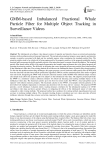
Статья научная
The imbalanced surveillance video dataset consists of majority and minority classes as normal and anomalous instances in the nonlinear and non-Gaussian framework. The normal and anomalous instances cause majority and minority samples or particles associated with high and low probable regions when considering the standard particle filter. The minority particles tend to be at high risk of being suppressed by the majority particles, as the proposal probability density function (pdf) encourages the highly probable regions of the input data space to remain a biased distribution. The standard particle filter-based tracker afflicts with sample degeneration and sample impoverishment due to the biased proposal pdf ignoring the minority particles. The difficulty in designing the correct proposal pdf prevents particle filter-based tracking in the imbalanced video data. The existing methods do not discuss the imbalanced nature of particle filter-based tracking. To alleviate this problem and tracking challenges, this paper proposes a novel fractional whale particle filter (FWPF) that fuses the fractional calculus-based whale optimization algorithm (FWOA) and the standard particle filter under weighted sum rule fusion. Integrating the FWPF with an iterative Gaussian mixture model (GMM) with unbiased sample variance and sample mean allows the proposal pdf to be adaptive to the imbalanced video data. The adaptive proposal pdf leads the FWPF to a minimum variance unbiased estimator for effectively detecting and tracking multiple objects in the imbalanced video data. The fractional calculus up to the first four terms makes the FWOA a local and global search operator with inherent memory property. The fractional calculus in the FWOA oversamples minority particles to be diversified with multiple imputations to eliminate data distortion with low bias and low variance. The proposed FWPF presents a novel imbalance evaluation metric, tracking distance correlation for the imbalanced tracking over UCSD surveillance video data and shows greater efficacy in mitigating the effects of the imbalanced nature of video data compared to other existing methods. The proposed method also outshines the existing methods regarding precision and accuracy in tracking multiple objects. The consistent tracking distance correlation near zero values provides efficient imbalance reduction through bias-variance correction compared to the existing methods.
Бесплатно
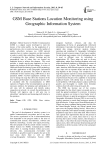
GSM Base Stations Location Monitoring using Geographic Information System
Статья научная
Global System for Mobile Communication (GSM) is a digital system developed to meet the desires of the entire public. As the population of a particular area, city or country increases, the number of mobile subscribers increases too. GSM network operators have to reduce congestion on their networks in order to satisfy their subscribers, therefore, a means of monitoring the base stations' locations and the geographical area of where they are located are important factor to achieve this purpose. This work provides a simple step-by-step approach on how to monitor the location of the base stations. A review of GSM and Global Positioning System (GPS) technology and their applications to the Geographic Information System (GIS) are presented. The means of taken the coordinates of base stations using a GPS device is also presented. ESRI's ArcView application software was used to design the map that shows the location of the base station and thereafter was integrated into the web. It concluded with the recommendation to GSM operators in Nigeria. If the recommendations are given necessary attention, the planning and optimization of cell sites will be enhanced and thereby reduce congestion on network. As a result, the performance of Network will improve, and it will give rise to subscribers' satisfaction and increasing profit returns to the operators.
Бесплатно
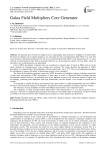
Galua Field Multipliers Core Generator
Статья научная
An important part of based on elliptical curves cryptographic data protection is multipliers of Galois fields. For based on elliptical curves digital signatures, not only prime but also extended Galois fields GF(pm) are used. The article provides a theoretical justification for the use of extended Galois fields GF(dm) with characteristics d > 2, and a criterion for determining the best field is presented. With the use of the proposed criterion, the best fields, which are advisable to use in data protection, are determined. Cores (VHDL descriptions of digital units) are considered as structural part of based on FPGA devices. In the article methods for cryptoprocessors cores creating were analyzed. The article describes the generator of VHDL descriptions of extended Galois field multipliers with big characteristic (up to 2998). The use of mathematical packages for calculations to improve the quality of information security is also considered. The Galois field multipliers generator creates the VHDL description of multipliers schemes, describes connections of their parts and generates VHDL descriptions of these parts as result of Quine-McCluskey Boolean functions minimization method. However, the execution time of the algorithm increases with increasing amount of input data. Accordingly, generating field multipliers with large characteristic can take frерom a few seconds to several tens of seconds. It's important to simplify the design and minimize logic gates number in a field programmable gate array (FPGA) because it will speed up the operation of multipliers. The generator creates multipliers according to the three variants. The efficiency of using multipliers for fields with different characteristics was compared in article. The expediency of using extended Galois fields GF(dm) with characteristics d > 2 in data protection tools is analyzed, a criterion for comparing data protection tools based on such Galois fields is determined, and the best fields according to the selected criterion when implemented according to a certain algorithm are determined.
Бесплатно
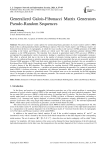
Generalized Galois-Fibonacci Matrix Generators Pseudo-Random Sequences
Статья научная
The article discusses various options for constructing binary generators of pseudo-random numbers (PRN) based on the so-called generalized Galois and Fibonacci matrices. The terms "Galois matrix" and "Fibonacci matrix" are borrowed from the theory of cryptography, in which the linear feedback shift registers (LFSR) generators of the PRN according to the Galois and Fibonacci schemes are widely used. The matrix generators generate identical PRN sequences as the LFSR generators. The transition from classical to generalized matrix PRN generators (PRNG) is accompanied by expanding the variety of generators, leading to a significant increase in their cryptographic resistance. This effect is achieved both due to the rise in the number of elements forming matrices and because generalized matrices are synthesized based on primitive generating polynomials and polynomials that are not necessarily primitive. Classical LFSR generators of PRN (and their matrix equivalents) have a significant drawback: they are susceptible to Berlekamp-Messi (BM) attacks. Generalized matrix PRNG is free from BM attack. The last property is a consequence of such a feature of the BM algorithm. This algorithm for cracking classical LFSR generators of PRN solves the problem of calculating the only unknown – a primitive polynomial generating the generator. For variants of generalized matrix PRNG, it becomes necessary to determine two unknown parameters: both an irreducible polynomial and a forming element that produces a generalized matrix. This problem turns out to be unsolvable for the BM algorithm since it is designed to calculate only one unknown parameter. The research results are generalized for solving PRNG problems over a Galois field of odd characteristics.
Бесплатно
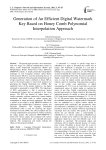
Статья научная
The present paper provides a new mechanism with two stages for efficient authentication based on Honey Comb Polynomial Interpolation (HCPI) and Morphological Border Sorted Pixel Value Difference (MBSPVD) scheme. A simple polynomial interpolation technique on new hexagonal structure called Honey Comb structure (HCS) is used for generating the key of the digital watermark. The polynomial interpolation gives a high secured key, which is difficult to break. HCS is used in the present paper to select pixel positions for generating the Digital Watermark key (DWK). The significant factor of the present method is, the digital watermark is generated by using DWK. The importance of HCS representation is that it possesses special computational features that are pertinent to the vision process. The HCS has features of higher degree of circular symmetry, uniform connectivity, greater angular resolution, and which leads to reduce storage and computation in image processing operations. The DWK is placed in the image by using MBSPVD method. Its guarantees high authentication, robustness, security and copyright protection. The Lagrange Polynomial interpolation (LPI) is used for retrieving the digital watermark from the DWK. The LPI accomplish the aim of image authentication and protection without reducing the image quality. The proposed HCPI-MBSPVD is tested with various attacks and compared with various existing image authentication and copyright protection methods. The comparisons and results indicate the efficacy of the proposed method.
Бесплатно
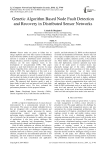
Genetic Algorithm Based Node Fault Detection and Recovery in Distributed Sensor Networks
Статья научная
Sensor nodes are prone to failure due to energy depletion and some other reasons in Distributed Sensor Networks (DSNs). In this regard fault tolerance of network is essential in distributed sensor environment. Energy efficiency, network or topology control and fault-tolerance are the most important issues in the development of next-generation DSNs. This paper proposes a node fault detection and recovery by using Genetic Algorithm (GA), when some of the sensor nodes faulty in DSN. The main objective of this work is to provide fault tolerance mechanism, which is energy efficient and responsive to network by using GA which is used to detect the faulty of nodes in the network based on the energy depletion of node and link failure between nodes. The proposed fault detection model is used to detect faults at node level and network level faults (link failure and packet error). We have evaluated the performance parameters for the proposed scheme.
Бесплатно
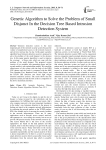
Статья научная
Intrusion detection system is the most important part of the network security system because the volume of unauthorized access to the network resources and services increase day by day. In this paper a genetic algorithm based intrusion detection system is proposed to solve the problem of the small disjunct in the decision tree. In this paper genetic algorithm is used to improve the coverage of those rules which are cope with the problem of the small disjunct. The proposed system consists of two modules rule generation phase, and the second module is rule optimization module. We tested the effectiveness of the system with the help of the KDD CUP dataset and the result is compared with the REP Tree, Random Tree, Random Forest, Na?ve Bayes, and the DTLW IDS (decision tree based light weight intrusion detection system). The result shows that the proposed system provide the best result in comparison to the above mentioned classifiers.
Бесплатно
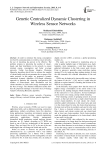
Genetic Centralized Dynamic Clustering in Wireless Sensor Networks
Статья научная
In order to minimize the energy consumption involved by communications in wireless sensor networks, the use of clustering has proven to be effective. The problem remains to determine the number of cluster-heads, and their distribution in the network to ensure minimal energy consumption and better coverage networks. Unlike Low-Energy Adaptive Clustering Hierarchy algorithm which fixes in advance the number of cluster-heads, and do not guarantee the coverage of the entire network, in this paper, we proposed a genetic centralized dynamic algorithm (GA)-based clustering approach to optimize the clustering configuration (the number of cluster-heads, their distribution and the cluster-members) to limit node energy consumption and the best coverage. The obtained simulation results show that the proposed technique overcomes the Low-Energy Adaptive Clustering Hierarchy algorithm.
Бесплатно

